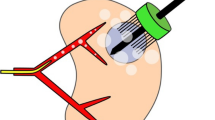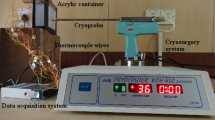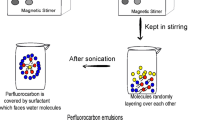Abstract
Purpose
To elucidate the basic thermophysical properties at low temperatures of lipiodol, which is used as a marker by transarterial injection before CT-guided cryoablation for solid tumors, by fundamental experiments with pure lipiodol phantom.
Materials and Methods
The freezing point of lipiodol was measured using differential scanning calorimeter (DSC) by detecting differences in the heating rate during heating from − 30 °C. Freezing experiments were conducted using pure lipiodol and a tissue phantom, which were prepared in an acrylic container at 37 °C. The growth of the frozen region was observed for 10 min. Temperatures were monitored at the cryoprobe surface and designated positions around the cryoprobe.
Results
The DSC experiment showed that freezing was observed between − 5 and − 30 °C, which indicated that the freezing point was approximately − 5 °C. Freezing experiments revealed that the diameter of frozen region in the lipiodol was smaller than that in the tissue phantom (5 mm vs 24 mm) after 10-min freezing. The temperature at the probe surface was − 130 °C in lipiodol, which was 25 °C lower than that in the tissue phantom. There was a larger temperature gradient near the cryoprobe in lipiodol due to lower thermal conductivity.
Conclusions
The present results suggest that an extremely high concentration of lipiodol (close to pure lipiodol) potentially reduces frozen region because of its lower freezing point and smaller thermal conductivity. However, since lipiodol concentrations in clinical cases differ from the current model, further studies using models that are close to clinical conditions are required.
Level of Evidence
No level of evidence, laboratory investigation.






Similar content being viewed by others
References
Tsitskari M, Christos G. Percutaneous cryoablation for renal cell carcinoma. J Kidney Cancer VHL. 2015;2(3):105–13.
Lang EK, Zhang KK, Nguyen Q, et al. Efficacy of percutaneous cryoablation of renal cell carcinoma in older patients with medical comorbidities: outcome study in 70 patients. Can Urol Assoc J. 2015;9(5–6):E256–61.
Bhindi B, Mason RJ, Haddad MM, et al. Outcomes after cryoablation versus partial nephrectomy for sporadic renal tumors in a solitary kidney: a propensity score analysis. Eur Urol. 2018;73(2):254–9.
Uppot RN, Silverman SG, Zangoria RJ, et al. Imaging-guided percutaneous ablation of renal cell carcinoma: a primer of how we do it. AJR Am J Roentgenol. 2009;192(6):1558–70.
Allen BC, Remer EM. Percutaneous cryoablation of renal tumors: patient selection, technique, and postprocedural imaging. Radiographics. 2010;30(4):887–900.
Yamanaka T, Yamakado K, Fujimori M, et al. CT-guided percutaneous cryoablation in renal cell carcinoma: factors affecting local tumor control. J Vasc Interv Radiol. 2015;26(8):1147–53.
Michimoto K, Shimizu K, Kameoka Y, et al. Transcatheter arterial embolization with a mixture of absolute ethanol and iodized oil for poorly visualized endophytic renal masses prior to CT-guided percutaneous cryoablation. Cardiovasc Intervent Radiol. 2016;39(11):1589–94.
Miyazaki M, Iguchi T, Takaki H, et al. Ablation protocols and ancillary procedures in tumor ablation therapy: consensus from Japanese experts. Jpn J Radiol. 2016;34(9):647–56.
Gandhi S, Iannitti DA, Mayo-Smith WW, et al. Technical report: lipiodol-guided computed tomography for radiofrequency ablation of hepatocellular carcinoma. Clin Radiol. 2006;61(10):881–91.
Hongo F, Yamada Y, Ueda T, et al. Preoperative lipiodol marking and its role on survival and complication rates of CT-guided cryoablation for small renal masses. BMC Urol. 2017;17(1):10.
Xu KC, Niu LZ, Zhou Q, et al. Sequential use of transarterial chemoembolization and percutaneous cryosurgery for hepatocellular carcinoma. World J Gastroenterol. 2009;15(29):3664–9.
Saliken JC, Donnelly BJ, Rewcastle JC. The evolution and state of modern technology for prostate cryosurgery. Urology. 2002;60(2 suppl 1):26–33.
Shurrab M, Wang H, Kubo N, et al. The cooling performance of a cryoprobe: establishing guidelines for the safety margins in cryosurgery. Int J Refrig. 2016;67:308–18.
Nassu RT, Gonçalves LAG. Determination of melting point of vegetable oils and fats by differential scanning calorimetry (DSC) technique. Grasas Aceites. 1999;50(1):16–22.
Hlinková A, Havrlentová M, Šupová J, et al. Poppy seed (Papaver somniferum L.) effect of genotype and year of cultivation on variability in its lipid composition. J Microbiol Biotechnol Food Sci. 2012;1:908–22.
Bozen B, Temelli F. Chemical composition and oxidative stability of flax, safflower and poppy seed and seed oils. Bioresour Technol. 2008;99(14):6354–9.
de Man L, de Man JM, Blackman B. Physical and textural characteristics of some North American shortenings. J Am Oil Chem Soc. 1991;68:63–9.
Gerhertz W. Ullmann’s encyclopedia of industrial chemistry. Fats and oils, vol. A10. Weinheim: VCH; 1995.
George ET, editor. Handbook of hydraulic fluid technology. 2nd ed. Boca Raton: CRC Press; 2012. p. 820.
Funding
This work was supported by JSPS KAKENHI, Grant Number 26861013.
Author information
Authors and Affiliations
Corresponding author
Ethics declarations
Conflict of interest
The authors declare that they have no conflict of interest.
Ethical Approval
This article does not contain any studies with human participants or animals performed by any of the authors.
Informed Consent
For this type of study, consent for publication is not required.
Additional information
Publisher's Note
Springer Nature remains neutral with regard to jurisdictional claims in published maps and institutional affiliations.
Rights and permissions
About this article
Cite this article
Yoshikawa, T., Miura, H., Hirota, T. et al. Fundamental Evaluation of Thermophysical Properties of Lipiodol Associated with Cryoablation: Freezing Experiments Using Lipiodol Phantom. Cardiovasc Intervent Radiol 43, 514–519 (2020). https://doi.org/10.1007/s00270-019-02401-8
Received:
Accepted:
Published:
Issue Date:
DOI: https://doi.org/10.1007/s00270-019-02401-8




